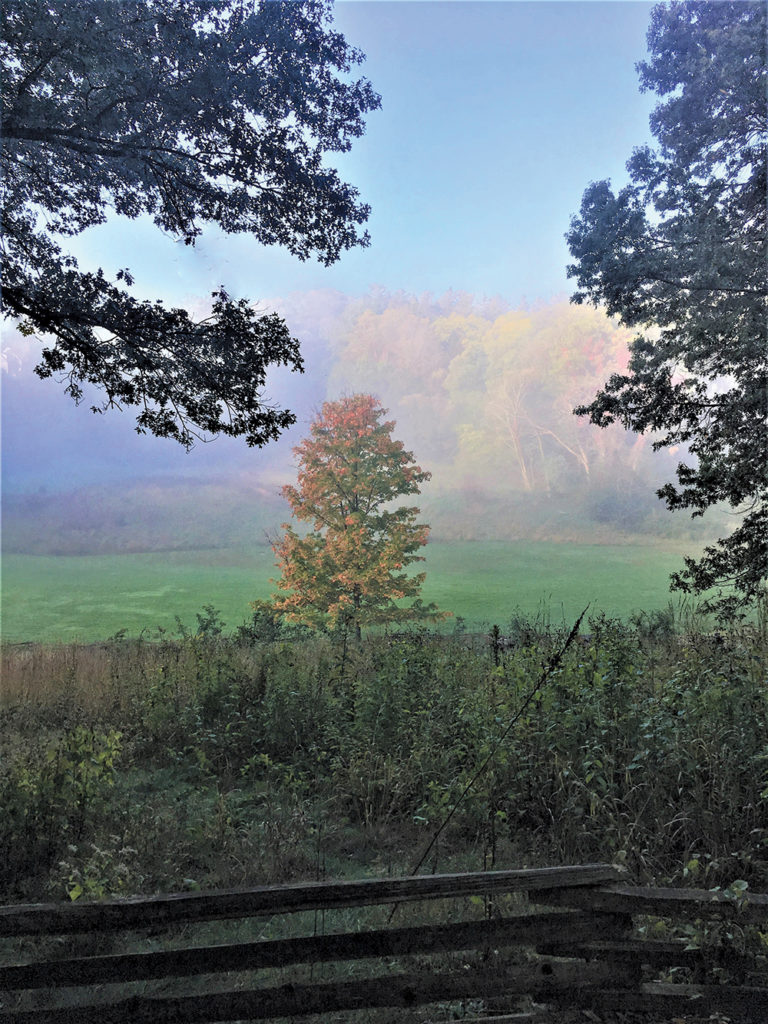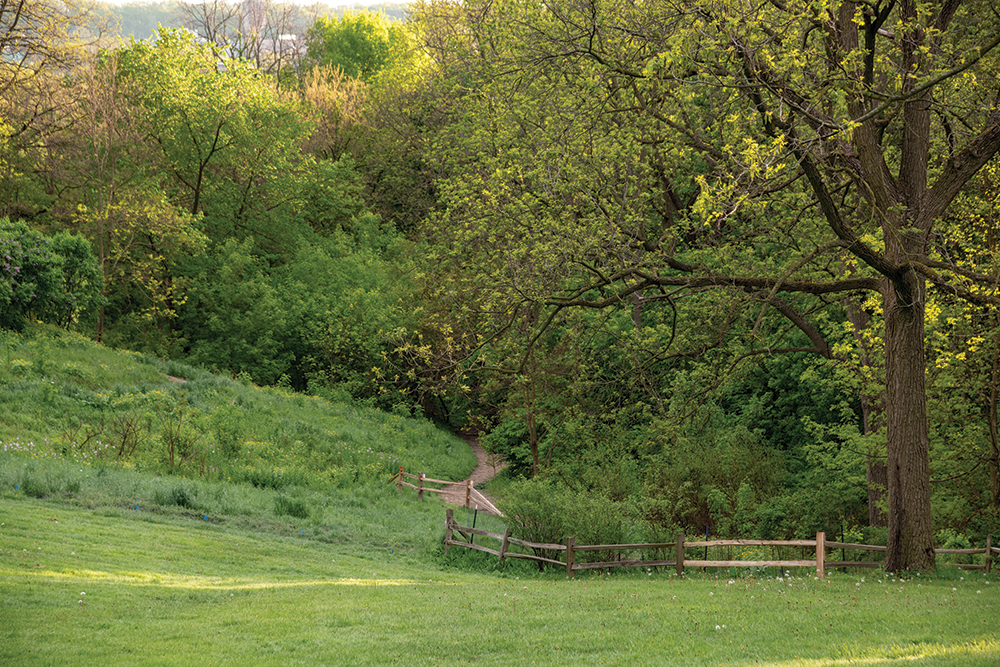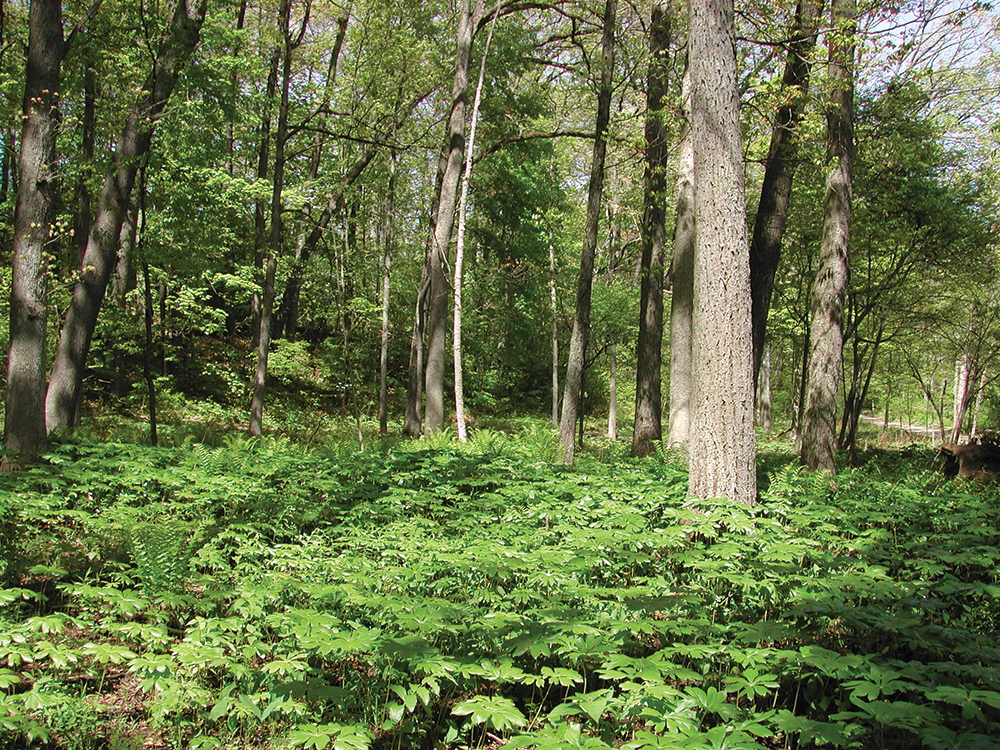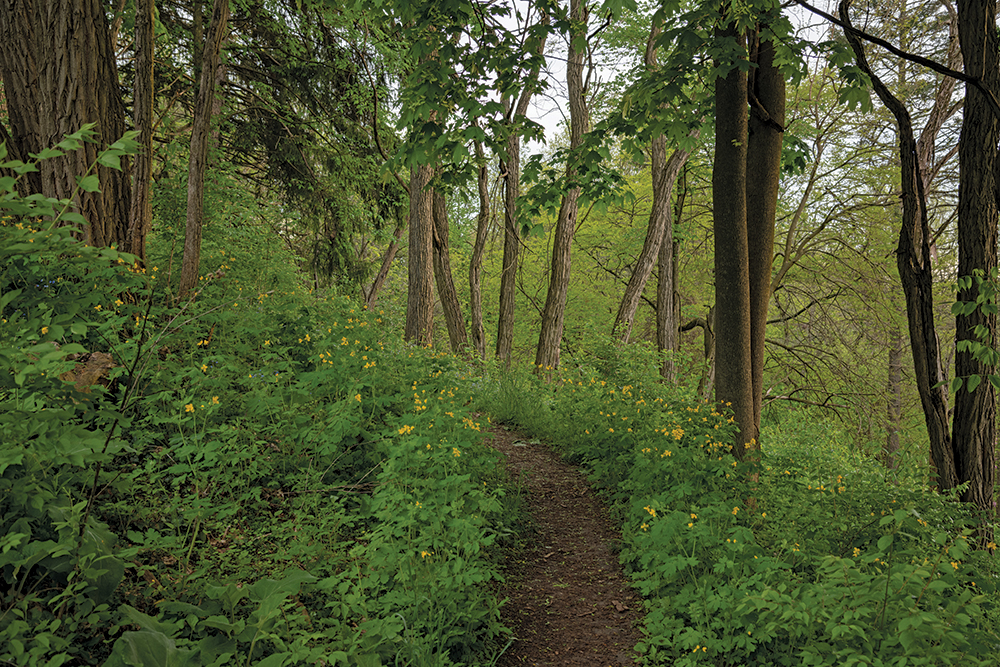Nearby Nature: O. C. Simonds and the Nichols Arboretum
Ann Arbor, Michigan

“A staunch defender of the natural charm of American landscapes, sensitive to beauty and skillful in the means of creating it, he has found joy and service in awakening civic ideals which express themselves in the development of city plans and parks. A better heritage for later days no man can leave.” —University of Michigan Regents, 1929, on awarding an honorary master’s degree to Ossian Cole Simonds
When the University of Michigan was founded in 1817, its leaders recognized that facilities such as museums, libraries, and botanical gardens would ultimately be needed by the great institution they envisioned. Although a schematic plan for the university from the 1830s shows nearly a third of central campus devoted to a botanical garden, it wasn’t until the late 1890s that the first one—small, focused on medicinal plants—was actually created. But soon the search was on for a larger site.
A team led by the U of M botany professors Frederick Newcomb and George Burns commissioned the well-known landscape architect and Michigan alumnus O. C. Simonds to help scout and review potential sites. The best option appeared to be a dramatic, hilly parcel of about twenty-five acres that was a short walk from central campus. Walter and Esther Nichols, both also Michigan alumni, were willing to donate the land, and the City of Ann Arbor, which owned adjacent property, agreed to collaborate on a botanical garden as a joint venture. By 1906, Simonds had laid out a plan for the property, and a year later the new garden opened. Ultimately renamed the Nichols Arboretum, the parklike landscape would become one of the most cherished open spaces in Ann Arbor.
The steeply sloping site featured a variety of glacial landforms and topography that dropped nearly two hundred feet from Geddes Avenue on the south to the Huron River on the north. According to Simonds, this variable terrain provided “an exceptional opportunity to grow plants of all kinds.” In comments to the university’s Board of Regents, Newcomb also noted presciently:
“In this University we have been able to work without a botanic garden, because we have been able to use the whole surrounding country for our field of study. But one can foresee that in twenty-five years the farmer’s woodlots will be put under cultivation for timber, the bogs will be drained, and no land will be left where vegetation can be studied in natural conditions. The land of the proposed donation is ideal for the purposes of bringing together in a small area all the vegetation of this climate, giving to each plant society its characteristic conditions. The tract is made up of hills, ravines, level low land, a bog, and a rivulet.”
Newcomb continued:
“It is the idea of the donors and myself that the tract of land could be treated and maintained at relatively small expense by restoring to these hills, ravines, and meadows the natural grouping of plants, leaving them with a little aid to care for themselves. This done, the University students of the future and the school children would have a field within fifteen minutes’ walk of the Campus where practically all the lessons taught by vegetation growth could be learned.”
The new botanical garden opened to the public in 1907 with only limited improvements. The main roads were realized according to Simonds’s plans and plantings initiated, but not all of them were native. Some of the earliest turned out to be highly invasive exotics, such as common buckthorn (Rhamnus cathartica) and shrub honeysuckle (Lonicera spp.). As well, botany faculty experimented with plants related to research, in particular Asiatic species that were being tested in Michigan’s climate. Within a few years, faculty botanists became disillusioned with the diverse terrain of the property, which precluded the construction of greenhouse complexes necessary for broader plant research. By 1914, when the university had secured a separate property for a new botanical garden, the question arose of what to do with the old one. The roughly planted parcel was turned over to the new landscape design program at the university and, in 1922, renamed the Nichols Arboretum, soon and ever since known affectionately as “the Arb.”

Under the direction of the landscape architecture faculty, plant collections developed gradually according to the framework set up by Simonds. The cleared valleys were kept as open meadows with various trees and shrubs planted around their perimeter. Many of the glacial kames that had been cleared of native oak forest were planted with groups of conifers—white pine, scotch pine, and spruce—per forestry practices on cutover lands throughout Michigan. A teaching shrub collection was initiated at the southern, higher edge of the Arb, with views across the Huron River Valley to the north. Plant collections were generally arranged by plant family with a general eye to aesthetics and their overall landscape effect.
The concept of an arboretum did not go without challenge, however, as the perceived need for recreational facilities close to central campus was deemed important. The steep topography of the glacial kames were perfect for sledding, skiing, and other winter sports, and in 1921, the engineering professor Ferdinand Northrup Menefee proposed that the university convert significant parts of the property to a winter sports complex as a way of combatting “the evils of student life” during Michigan’s long gray winters. Arb director Aubrey Tealdi passionately opposed the idea, noting that the “scientific development of the arboretum and its use for sports are incompatible. You can’t keep a lion and a lamb in the same cage.” The debate raged through the 1920s until 1934, when university president Alexander Ruthven convened a committee to decide the issue and the future of the Arb’s land. Ultimately, the decision was made to continue to support the land’s use as an arboretum. As Tealdi noted, “The distant future should be carefully considered in the development of the area. It should be kept so that it might become a haven of quiet one hundred years from now when our rich native flora will have become a thing of the past in most places.”

One of Tealdi’s lasting legacies was the creation of a formal peony garden with donations of rare cultivars. The specimens were given by William Erastus Upjohn, founder of the Upjohn Pharmaceutical Company, and other peony enthusiasts; the collection was planted in 1922 and opened to visitors five years later. At that time, the university’s graduation coincided with the peony bloom in early June, and the Peony Garden joined several private gardens in Ann Arbor that were open to the public. In June 1935, the Ann Arbor News reported that peony bloom across the city gave Ann Arbor “a distinctive charm in the glamorous days, the lingering twilights, and the moon-lit nights of the commencement period.” Today, with eight hundred herbaceous peonies, tree peonies, and intersectional hybrids, the Peony Garden remains a cherished local landmark and a valuable reference collection of historic cultivars.
The Nichols Arboretum’s diverse nature settings are also deeply revered by visitors. Simonds’s general approach to design, treating the landscape as a series of outdoor rooms, provided the arboretum with a progressive series of spaces where people can gracefully disperse, a scheme that allows the landscape to absorb the 330,000 or so estimated yearly visitors without feeling crowded. Today, the acreage comprises about 128 acres.

Among the most distinctive of these spaces is the “main valley,” which was kept open in the original design and serves as a place for informal picnics, tossing a Frisbee, or playing Quidditch (a game from Harry Potter novels). Heathdale supports a collection of Appalachian azalea, rhododendron, mountain laurel, and other acid-loving broad-leaved evergreens set against a native Michigan oak-hickory forest. Magnolia Glade features a collection of southern Appalachian magnolia trees and cultivars from around the world, many of which came from the remarkable Michigan breeder Phil Savage. The River Landing area serves as a gathering spot along the Huron, and Dow Field supports remnant prairie and oak savanna areas. It is currently being restored through fire management.
In the past two decades, programming at the Nichols Arboretum has included a number of arts performances inspired by and integrated with settings throughout the landscape. These have included children’s storytelling events, dance and musical performances, and recordings of unique outdoor sounds. One of the most durable examples of the fusion of “performance” and “landscape” has been “Shakespeare in the Arb,” which began in 2001 in partnership with the drama program in the university’s Residential College. Kate Mendeloff, the creative force behind these productions, has staged a number of Shakespeare’s plays in the arboretum which involve the audience’s moving along with the actors to different settings as the scenes unfold. These Shakespeare productions have given the arboretum landscape a magical quality for many visitors, who half expect to find fairies hiding behind trees, festive wedding dances in open glades, or funerals in solemn groves.
When the founders of Nichols Arboretum wrote that they were determined to secure a place “within fifteen minutes’ walk of the Campus where practically all the lessons taught by vegetation growth could be learned,” they couldn’t have imagined how the city and campus would grow to completely envelop the green oasis. Now the landscape is bounded by one of the country’s largest medical complexes on one side and a variety of residential neighborhoods—including private homes, apartments, university dormitories, and fraternity and sorority houses—on the other.

There is little question that encroaching urbanism has taken its toll. Runoff from parking lots and city streets threatens steep ravines with erosion; major sewer lines running through the area have occasionally developed leaks; and medical helicopters flying overhead disturb the quiet with their roar. The landscape has been severely challenged by legacies of invasive plants and by deer populations that have exploded in recent decades. These threats require constant vigilance and careful management. But, even with these challenges, the Arb continues to provide critical relief—whether from a hospital patient’s window or for someone just needing a place of nearby nature to clear their mind.
In this period of sequestration during COVID-19, places of nearby nature like the Nichols Arboretum are even more valuable. They serve as a reminder of the foresight of past generations in nurturing pockets of beauty in the midst of our cities. Patients and visitors can literally move from surgical wards to native woods and fields within a five-minute walk. Recovering patients sometimes point to the hospital and say, “There’s where I go for my treatments but here is where I come for my therapy.” Students frequently remark on how important the Arb is as a place to hang out and maintain their sanity in balancing the pressures of an academic life. Countless others from the community also come seeking respite and refuge.

Having served as director of this revered place for nearly twenty years, I am constantly reminded of the fragility of urban nature and the need for careful stewardship to protect the remnants of wild nature as well as garden spaces in the heart of any city. The designed beauty of such landscapes is easily lost. As the late landscape architect Alfred Caldwell once told me, “making landscapes is like making angels in the snow. Wait an afternoon and they’re gone.”
We have been fortunate at Nichols Arboretum that the long string of directors has helped to keep structural features of Simonds’s original design intact through the years. And, during my tenure, we have been aided by teams of dedicated volunteers and thoughtful staff who have helped manage and restore this dynamic landscape according to Simonds’s principles. For me personally, it has been a joy to help steward a place that is beloved by so many people and to see firsthand the value of nearby nature in people’s lives.
In his lecture “Parks,” delivered at the university in 1909, Simonds spoke about his sense of the importance of nature from a heartfelt perspective:
I wish that all the children of the present day, as well as their fathers and mothers, could have some place to go where they could sit quietly and enjoy nature, or where they could romp about and play on the grass, or go in wading or swimming; a place where they could become acquainted with the shapes of all the leaves and their habits of growth; with the perfume of the linden and lilac, with the songs of the thrushes and cat-birds, with the motions of the chipmunk, and, in short, all the charms of the country.
For the people of Ann Arbor, he provided just such a place.
Robert E. Grese, FASLA/FCELA, is Professor Emeritus of Environment and Sustainability at the University of Michigan, author of Jens Jensen: Maker of Natural Parks and Gardens, editor of The Native Landscape Reader (LALH, 2011), and coeditor of Passion for Peonies, a history of the Nichols Arboretum Peony Garden.